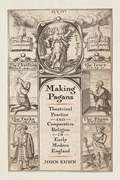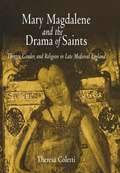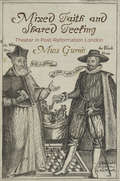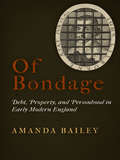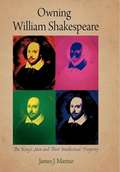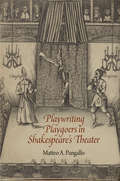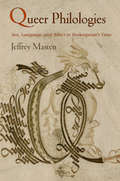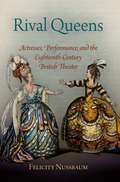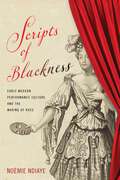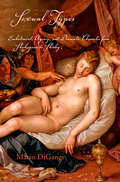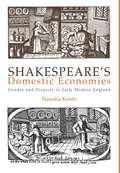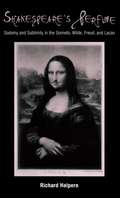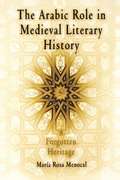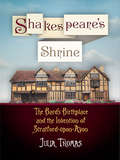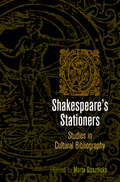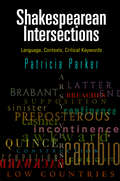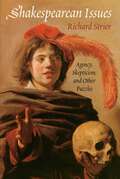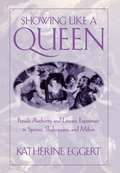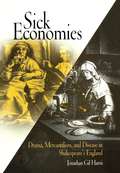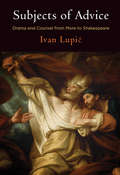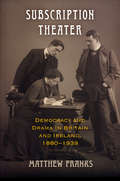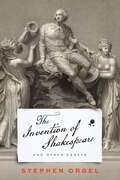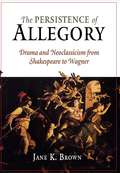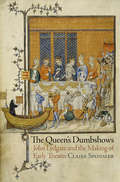- Table View
- List View
Making Pagans: Theatrical Practice and Comparative Religion in Early Modern England (Published in cooperation with the Folger Shakespeare Library)
by John KuhnHow early modern theatrical practice helped construct the category of “pagan” as a tool of European self-definition and colonial ambitionIn Making Pagans, John Kuhn argues that drama played a powerful role in the articulation of religious difference in the seventeenth century. Tracing connections between the history of stagecraft and ethnological disciplines such as ethnography, antiquarianism, and early comparative religious writing, Kuhn shows how early modern repertory systems that leaned heavily on thrift and reuse produced an enduring theatrical vocabulary for understanding religious difference through the representation of paganism—a key term in the new taxonomy of world religions emerging at this time, and a frequent subject and motif in English drama of the era.Combining properties such as triumphal chariots, trick altars, and moving statues with music, special effects, and other elements, the spectacular set-pieces that were mostly developed for plays set in antiquity, depicting England’s pre-Christian past, were frequently repurposed in new plays, in representations of Native Americans and Africans in colonial contact zones. Kuhn argues that the recycling of these set-pieces encouraged audiences to process new cultural sites through the lens of old performance tropes, and helped produce fictitious, quasi-ethnographic knowledge for spectators, generating the idea of a homogeneous, trans-historical, trans-geographical “paganism.” Examining the common scenes of pagan ritual that filled England's seventeenth-century stages—magical conjurations, oracular prophecies, barbaric triumphal parades, and group suicides—Kuhn traces these tropes across dozens of plays, from a range of authors including Ben Jonson, Christopher Marlowe, John Dryden, and Philip Massinger.Drawing together theater history, Atlantic studies, and the history of comparative religion, Making Pagans reconceptualizes the material and iterative practices of the theater as central to the construction of radical religious difference in early modernity and of the category of paganism as a tool of European self-definition and colonial ambition.
Mary Magdalene and the Drama of Saints
by Theresa ColettiA sinner-saint who embraced then renounced sexual and worldly pleasures; a woman who, through her attachment to Jesus, embodied both erotic and sacred power; a symbol of penance and an exemplar of contemplative and passionate devotion: perhaps no figure stood closer to the center of late medieval debates about the sources of spiritual authority and women's contribution to salvation history than did Mary Magdalene, and perhaps nowhere in later medieval England was cultural preoccupation with the Magdalene stronger than in fifteenth-century East Anglia.Looking to East Anglian texts including the N-Town Plays, The Book of Margery Kempe, The Revelations of Julian of Norwich, and Bokenham's Legend of Holy Women, Theresa Coletti explores how the gendered symbol of Mary Magdalene mediates tensions between masculine and feminine spiritual power, institutional and individual modes of religious expression, and authorized and unauthorized forms of revelation and sacred speech. Using the Digby play Mary Magdalene as her touchstone, Coletti engages a wide variety of textual and visual resources to make evident the discursive and material ties of East Anglian dramatic texts and feminine religion to broader traditions of cultural commentary and representation.In bringing the disciplinary perspectives of literary history and criticism, gender studies, and social and religious history to bear on specific local instances of dramatic practice, Mary Magdalene and the Drama of Saints highlights the relevance of Middle English dramatic discourse to the dynamic religious climate of late medieval England. In doing so, the book decisively challenges the marginalization of drama within medieval English studies, elucidates vernacular theater's kinship with influential late medieval religious texts and institutions, and articulates the changing possibilities for sacred representation in the decades before the Reformation.
Mixed Faith and Shared Feeling: Theater in Post-Reformation London
by Musa GurnisMixed Faith and Shared Feeling explores the mutually generative relationship between post-Reformation religious life and London's commercial theaters. It explores the dynamic exchange between the imaginatively transformative capacities of shared theatrical experience, with the particular ideological baggage that individual playgoers bring into the theater. While early modern English drama was shaped by the polyvocal, confessional scene in which it was embedded, Musa Gurnis contends that theater does not simply reflect culture but shapes it. According to Gurnis, shared theatrical experience allowed mixed-faith audiences to vicariously occupy alternative emotional and cognitive perspectives across the confessional spectrum.In looking at individual plays, such as Thomas Middleton's A Game of Chess and Shakespeare's Measure for Measure, Gurnis shows how theatrical process can restructure playgoers' experiences of confessional material and interrupt dominant habits of religious thought. She refutes any assumption that audiences consisted of conforming Church of England Protestants by tracking the complex and changing religious lives of seventy known playgoers. Arguing against work that seeks to draw fixed lines of religious affiliation around individual playwrights or companies, she highlights the common practice of cross-confessional collaboration among playhouse colleagues. Mixed Faith and Shared Feeling demonstrates how post-Reformation representational practices actively reshaped the ways ideologically diverse Londoners accessed the mixture of religious life across the spectrum of beliefs.
Of Bondage
by Amanda BaileyThe late sixteenth-century penal debt bond, which allowed an unsatisfied creditor to seize the body of his debtor, set in motion a series of precedents that would shape the legal, philosophical, and moral issue of property-in-person in England and America for centuries. Focusing on this historical juncture at which debt litigation was not merely an aspect of society but seemed to engulf it completely, Of Bondage examines a culture that understood money and the body of the borrower as comparable forms of property that impinged on one another at the moment of default.Amanda Bailey shows that the early modern theater, itself dependent on debt bonds, was well positioned to stage the complex ethical issues raised by a system of forfeiture that registered as a bodily event. While plays about debt like The Merchant of Venice and The Custom of the Country did not use the language of political philosophy, they were artistically and financially invested in exploring freedom as a function of possession. By revealing dramatic literature's heretofore unacknowledged contribution to the developing narrative of possessed persons, Amanda Bailey not only deepens our understanding of creditor-debtor relations in the period but also sheds new light on the conceptual conditions for the institutions of indentured servitude and African slavery. Of Bondage is vital not only for students and scholars of English literature but also for those interested in British and colonial legal history, the history of human rights, and the sociology of economics.
Owning William Shakespeare
by James J. MarinoCopyright is by no means the only device for asserting ownership of a work. Some writers, including playwrights in the early modern period, did not even view print copyright as the most important of their authorial rights. A rich vein of recent scholarship has examined the interaction between royal monopolies, which have been identified with later notions of intrinsic authorial ownership, and the internal copy registration practices of the English book trades. Yet this dialogue was but one part of a still more complicated conversation in early modern England, James J. Marino argues; other customs and other sets of professional demands were at least as important, most strikingly in the exercise of the performance rights of plays.In Owning William Shakespeare James Marino explores the actors' system of intellectual property as something fundamentally different from the property regimes exercised by the London printers or the royal monopolists. Focusing on Hamlet, The Taming of the Shrew, King Lear, and other works, he demonstrates how Shakespeare's acting company asserted ownership of its plays through intense rewriting combined with progressively insistent attribution to Shakespeare. The familiar versions of these plays were created through ongoing revision in the theater, a process that did not necessarily begin with Shakespeare's original manuscript or end when he died. An ascription by the company of any play to "Shakespeare" did not imply that it was following a fixed, authorial text; rather, Marino writes, it indicates an attempt to maintain exclusive control over a set of open-ended, theatrically revised scripts.Combining theater history, textual studies, and literary theory, Owning William Shakespeare rethinks both the way Shakespeare's plays were created and the way they came to be known as his. It overturns a century of scholarship aimed at re-creating the playwright's lost manuscripts, focusing instead on the way the plays continued to live and grow onstage.
Playwriting Playgoers in Shakespeare's Theater
by Matteo A. PangalloAmong the dramatists who wrote for the professional playhouses of early modern London was a small group of writers who were neither members of the commercial theater industry writing to make a living nor aristocratic amateurs dipping their toes in theatrical waters for social or political prestige. Instead, they were largely working- and middle-class amateurs who had learned most of what they knew about drama from being members of the audience.Using a range of familiar and lesser-known print and manuscript plays, as well as literary accounts and documentary evidence, Playwriting Playgoers in Shakespeare's Theater shows how these playgoers wrote and revised to address what they assumed to be the needs of actors, readers, and the Master of the Revels; how they understood playhouse materials and practices; and how they crafted poetry for theatrical effects. The book also situates them in the context of the period's concepts of, and attitudes toward, playgoers' participation in the activity of playmaking.Plays by playgoers such as the rogue East India Company clerk Walter Mountfort or the highwayman John Clavell invite us into the creative imaginations of spectators, revealing what certain audience members wanted to see and how they thought actors might stage it. By reading Shakespeare's theater through these playgoers' works, Matteo Pangallo contributes a new category of evidence to our understanding of the relationships between the early modern stage, its plays, and its audiences. More broadly, he shows how the rise of England's first commercialized culture industry also gave rise to the first generation of participatory consumers and their attempts to engage with mainstream culture by writing early modern "fan fiction."
Queer Philologies: Sex, Language, and Affect in Shakespeare's Time
by Jeffrey MastenFor Jeffrey Masten, the history of sexuality and the history of language are intimately related. In Queer Philologies, he studies particular terms that illuminate the history of sexuality in Shakespeare's time and analyzes the methods we have used to study sex and gender in literary and cultural history. Building on the work of theorists and historians who have, following Foucault, investigated the importance of words like "homosexual," "sodomy," and "tribade" in a variety of cultures and historical periods, Masten argues that just as the history of sexuality requires the history of language, so too does philology, "the love of the word," require the analytical lens provided by the study of sexuality.Masten unpacks the etymology, circulation, transformation, and constitutive power of key words within the early modern discourse of sex and gender--terms such as "conversation" and "intercourse," "fundament" and "foundation," "friend" and "boy"--that described bodies, pleasures, emotions, sexual acts, even (to the extent possible in this period) sexual identities. Analyzing the continuities as well as differences between Shakespeare's language and our own, he offers up a queer lexicon in which the letter "Q" is perhaps the queerest character of all.
Rival Queens
by Felicity NussbaumIn eighteenth-century England, actresses were frequently dismissed as mere prostitutes trading on their sexual power rather than their talents. Yet they were, Felicity Nussbaum argues, central to the success of a newly commercial theater. Urban, recently moneyed, and thoroughly engaged with their audiences, celebrated actresses were among the first women to achieve social mobility, cultural authority, and financial independence. In fact, Nussbaum contends, the eighteenth century might well be called the "age of the actress" in the British theater, given women's influence on the dramatic repertory and, through it, on the definition of femininity.Treating individual star actresses who helped spark a cult of celebrity--especially Anne Oldfield, Susannah Cibber, Catherine Clive, Margaret Woffington, Frances Abington, and George Anne Bellamy--Rival Queens reveals the way these women animated issues of national identity, property, patronage, and fashion in the context of their dramatic performances. Actresses intentionally heightened their commercial appeal by catapulting the rivalries among themselves to center stage. They also boldly rivaled in importance the actor-managers who have long dominated eighteenth-century theater history and criticism. Felicity Nussbaum combines an emphasis on the celebrated actresses themselves with close analysis of their diverse roles in works by major playwrights, including George Farquhar, Nicholas Rowe, Colley Cibber, Arthur Murphy, David Garrick, Isaac Bickerstaff, and Richard Sheridan. Hers is a comprehensive and original argument about the importance of actresses as the first modern subjects, actively shaping their public identities to make themselves into celebrated properties.
Scripts of Blackness: Early Modern Performance Culture and the Making of Race (RaceB4Race: Critical Race Studies of the Premodern)
by Noémie NdiayeScripts of Blackness shows how the early modern mass media of theatre and performance culture at-large helped turn blackness into a racial category, that is, into a type of difference justifying emerging social hierarchies and power relations in a new world order driven by colonialism and capitalism.In this book, Noémie Ndiaye explores the techniques of impersonation used by white performers to represent Afro-diasporic people in England, France, and Spain in the sixteenth and seventeenth centuries, using a comparative and transnational framework. She reconstructs three specific performance techniques—black-up (cosmetic blackness), blackspeak (acoustic blackness), and black dances (kinetic blackness)—in order to map out the poetics of those techniques, and track a number of metaphorical strains that early modern playtexts regularly associated with them. Those metaphorical strains, the titular scripts of blackness of this book, operated across national borders and constituted resources, as they provided spectators and participants with new ways of thinking about the Afro-diasporic people who lived or could/would ultimately live in their midst.Those scripts were often gendered and hinged on notions of demonization, exclusion, exploitation, animalization, commodification, sexualization, consensual enslavement, misogynoir, infantilization, and evocative association with other racialized minorities. Scripts of Blackness attempts to grasp the stories that Western Europeans told themselves through performative blackness, and the effects of those fictions on early modern Afro-diasporic subjects.
Sexual Types: Embodiment, Agency, and Dramatic Character from Shakespeare to Shirley
by Mario DiGangiSexual types on the early modern stage are at once strange and familiar, associated with a range of "unnatural" or "monstrous" sexual and gender practices, yet familiar because readily identifiable as types: recognizable figures of literary imagination and social fantasy. From the many found in early modern culture, Mario DiGangi here focuses on six types that reveal in particularly compelling ways, both individually and collectively, how sexual transgressions were understood to intersect with social, gender, economic, and political transgressions.Building on feminist and queer scholarship, Sexual Types demonstrates how the sodomite, the tribade (a woman-loving woman), the narcissistic courtier, the citizen wife, the bawd, and the court favorite function as sites of ideological contradiction in dramatic texts. On the one hand, these sexual types are vilified and disciplined for violating social and sexual norms; on the other hand, they can take the form of dynamic, resourceful characters who expose the limitations of the categories that attempt to define and contain them. In bringing sexuality and character studies into conjunction with one another, Sexual Types provides illuminating new readings of familiar plays, such as Shakespeare's A Midsummer Night's Dream and The Winter's Tale, and of lesser-known plays by Fletcher, Middleton, and Shirley.
Shakespeare's Domestic Economies: Gender and Property in Early Modern England
by Natasha KordaShakespeare's Domestic Economies explores representations of female subjectivity in Shakespearean drama from a refreshingly new perspective, situating The Taming of the Shrew, The Merry Wives of Windsor, Othello, and Measure for Measure in relation to early modern England's nascent consumer culture and competing conceptions of property. Drawing evidence from legal documents, economic treatises, domestic manuals, marriage sermons, household inventories, and wills to explore the realities and dramatic representations of women's domestic roles, Natasha Korda departs from traditional accounts of the commodification of women, which maintain that throughout history women have been "trafficked" as passive objects of exchange between men.In the early modern period, Korda demonstrates, as newly available market goods began to infiltrate households at every level of society, women emerged as never before as the "keepers" of household properties. With the rise of consumer culture, she contends, the housewife's managerial function assumed a new form, becoming increasingly centered around caring for the objects of everyday life—objects she was charged with keeping as if they were her own, in spite of the legal strictures governing women's property rights. Korda deftly shows how their positions in a complex and changing social formation allowed women to exert considerable control within the household domain, and in some areas to thwart the rule of fathers and husbands.
Shakespeare's Perfume: Sodomy and Sublimity in the Sonnets, Wilde, Freud, and Lacan
by Richard HalpernStarting with St. Paul's argument that the Greeks were afflicted with homosexuality to punish their excessive love of statues, Richard Halpern uncovers a tradition in which aesthetic experience gives birth to the sexual—and thus reverses the Freudian thesis that erotic desire is sublimated into art. Rather, Halpern argues, sodomy was implicated with aesthetic categories from the very start, as he traces a connection between sodomy and the unrepresentable that runs from Shakespeare's Sonnets to Oscar Wilde's novella The Portrait of Mr. W.H., Freud's famous essay on Leonardo da Vinci, and Jacques Lacan's seminar on the ethics of psychoanalysis. Drawing on theology, alchemy, psychoanalysis, philosophy, and literary criticism, Shakespeare's Perfume explores how the history of aesthetics and the history of sexuality are fundamentally connected.
Shakespeare's Schoolroom: Rhetoric, Discipline, Emotion
by Lynn EnterlineShakespeare's Schoolroom places moments of considerable emotional power in Shakespeare's poetry—portraits of what his contemporaries called "the passions"—alongside the discursive and material practices of sixteenth-century English pedagogy. Humanist training in Latin grammar and rhetorical facility was designed to intervene in social reproduction, to sort out which differences between bodies (male and female) and groups (aristocrats, the middling sort, and those below) were necessary to producing proper English "gentlemen." But the method adopted by Lynn Enterline in this book uncovers a rather different story from the one schoolmasters invented to promote the social efficacy of their pedagogical innovations. Beginning with the observation that Shakespeare frequently reengaged school techniques through the voices of those it excluded (particularly women), Enterline shows that when his portraits of "love" and "woe" betray their institutional origins, they reveal both the cost of a Latin education as well as the contradictory conditions of genteel masculinity in sixteenth-century Britain.In contrast to attempts to explain early modern emotion in relation to medical discourse, Enterline uncovers the crucial role that rhetoric and the texts of the classical past play in Shakespeare's passions. She relies throughout on the axiom that rhetoric has two branches that continuously interact: tropological (requiring formal literary analysis) and transactional (requiring social and historical analysis). Each chapter moves between grammar school archives and literary canon, using linguistic, rhetorical, and literary detail to illustrate the significant difference between what humanists claimed their methods would achieve and what the texts of at least one former schoolboy reveal about the institution's unintended literary and social consequences. When Shakespeare creates the convincing effects of character and emotion for which he is so often singled out as a precursor of "modern" subjectivity, he signals his debt to the Latin institution that granted him the cultural capital of an early modern gentleman precisely when undercutting the socially normative categories schoolmasters invoked as their educational goal.
Shakespeare's Shrine
by Julia ThomasAnyone who has paid the entry fee to visit Shakespeare's Birthplace on Henley Street in Stratford-upon-Avon--and there are some 700,000 a year who do so--might be forgiven for taking the authenticity of the building for granted. The house, as the official guidebooks state, was purchased by Shakespeare's father, John Shakespeare, in two stages in 1556 and 1575, and William was born and brought up there. The street itself might have changed through the centuries--it is now largely populated by gift and tea shops--but it is easy to imagine little Will playing in the garden of this ancient structure, sitting in the inglenook in the kitchen, or reaching up to turn the Gothic handles on the weathered doors.In Shakespeare's Shrine Julia Thomas reveals just how fully the Birthplace that we visit today is a creation of the nineteenth century. Two hundred years after Shakespeare's death, the run-down house on Henley Street was home to a butcher shop and a pub. Saved from the threat of an ignominious sale to P. T. Barnum, it was purchased for the English nation in 1847 and given the picturesque half-timbered façade first seen in a fanciful 1769 engraving of the building. A perfect confluence of nationalism, nostalgia, and the easy access afforded by rail travel turned the house in which the Bard first drew breath into a major tourist attraction, one artifact in a sea of Shakespeare handkerchiefs, eggcups, and door-knockers.It was clear to Victorians on pilgrimage to Stratford just who Shakespeare was, how he lived, and to whom he belonged, Thomas writes, and the answers were inseparable from Victorian notions of class, domesticity, and national identity. In Shakespeare's Shrine she has written a richly documented and witty account of how both the Bard and the Warwickshire market town of his birth were turned into enduring symbols of British heritage--and of just how closely contemporary visitors to Stratford are following in the footsteps of their Victorian predecessors.
Shakespeare's Stationers: Studies in Cultural Bibliography (Material Texts)
by Marta StraznickyRecent studies in early modern cultural bibliography have put forth a radically new Shakespeare—a man of keen literary ambition who wrote for page as well as stage. His work thus comes to be viewed as textual property and a material object not only seen theatrically but also bought, read, collected, annotated, copied, and otherwise passed through human hands. This Shakespeare was invented in large part by the stationers—publishers, printers, and booksellers—who produced and distributed his texts in the form of books. Yet Shakespeare's stationers have not received sustained critical attention.Edited by Marta Straznicky, Shakespeare's Stationers: Studies in Cultural Bibliography shifts Shakespearean textual scholarship toward a new focus on the earliest publishers and booksellers of Shakespeare's texts. This seminal collection is the first to explore the multiple and intersecting forms of agency exercised by Shakespeare's stationers in the design, production, marketing, and dissemination of his printed works. Nine critical studies examine the ways in which commerce intersected with culture and how individual stationers engaged in a range of cultural functions and political movements through their business practices. Two appendices, cataloguing the imprints of Shakespeare's texts to 1640 and providing forty additional stationer profiles, extend the volume's reach well beyond the case studies, offering a foundation for further research.
Shakespearean Intersections: Language, Contexts, Critical Keywords (Haney Foundation Series)
by Patricia ParkerWhat does the keyword "continence" in Love's Labor's Lost reveal about geopolitical boundaries and their breaching? What can we learn from the contemporary identification of the "quince" with weddings that is crucial for A Midsummer Night's Dream? How does the evocation of Spanish-occupied "Brabant" in Othello resonate with contemporary geopolitical contexts, wordplay on "Low Countries," and fears of sexual/territorial "occupation"? How does "supposes" connote not only sexual submission in The Taming of the Shrew but also the transvestite practice of boys playing women, and what does it mean for the dramatic recognition scene in Cymbeline?With dazzling wit and erudition, Patricia Parker explores these and other critical keywords to reveal how they provide a lens for interpreting the language, contexts, and preoccupations of Shakespeare's plays. In doing so, she probes classical and historical sources, theatrical performance practices, geopolitical interrelations, hierarchies of race, gender, and class, and the multiple significances of "preposterousness," including reversals of high and low, male and female, Latinate and vulgar, "sinister" or backward writing, and latter ends both bodily and dramatic.Providing innovative and interdisciplinary perspectives on Shakespeare, from early to late and across dramatic genres, Parker's deeply evocative readings demonstrate how easy-to-overlook textual or semantic details reverberate within and beyond the Shakespearean text, and suggest that the boundary between language and context is an incontinent divide.
Shakespearean Issues: Agency, Skepticism, and Other Puzzles
by Richard StrierIn Shakespearean Issues, Richard Strier has written a set of linked essays bound by a learned view of how to think about Shakespeare’s plays and also how to write literary criticism on them. The essays vary in their foci—from dealing with passages and key lines to dealing with whole plays, and to dealing with multiple plays in thematic conversation with each other. Strier treats the political, social, and philosophical themes of Shakespeare’s plays through recursive and revisionary close reading, revisiting plays from different angles and often contravening prevailing views.Part I focuses on characters. Moments of bad faith, of unconscious self-revelation, and of semi-conscious self-revelation are analyzed, along with the problem of describing characters psychologically and ethically. In an essay on “Happy Hamlet,” the famous melancholy of the prince is questioned, as is the villainy of Rosencrantz and Guildenstern, while another essay asks the reader to reconsider moral judgments and negative assessments of characters who may be flawed but do not seem obviously wicked, such as Edgar and Gloucester in King Lear.Part II moves to systems, arguing that Henry IV, Measure for Measure, and The Merchant of Venice raise doubts about fundamental features of legal systems, such as impartiality, punishments, and respect for contracts. Strier reveals King Lear’s radicalism, analyzing its concentration on poverty and its insistence on the existence and legitimacy of a material substratum to human life. Essays on The Tempest offer original takes on the play’s presentation of coercive power, of civilization and its discontents, and of humanist ideals. Part III turns to religious and epistemological beliefs, with Strier challenging prevailing views of Shakespeare’s relation to both.A culminating reading sees The Winter’s Tale as ultimately affirming the mind’s capacities, and as finding a place for something like religion within the world. Anyone interested in Shakespeare’s plays will find Shakespearean Issues bracing and thought-provoking.
Showing Like a Queen: Female Authority and Literary Experiment in Spenser, Shakespeare, and Milton
by Katherine EggertFor most Renaissance English thinkers, queenship was a catastrophe, a political accident that threatened to emasculate an entire nation. But some English poets and playwrights proved more inventive in their responses to female authority. In Showing Like a Queen, Katherine Eggert argues that Spenser, Shakespeare, and Milton turned the political problem of queenship to their advantage by using it as an occasion to experiment with new literary genres. Unlike other critics who have argued that a queen provoked only anxiety and defensiveness in her male subjects, Eggert demonstrates that even after her death Elizabeth I's forty-five-year reign enabled writers to entertain the fantasy of a counterpatriarchal realm.Eggert traces a literary history of the late sixteenth and early seventeenth centuries in which the destabilizing anomaly of female rule enables Spenser to reshape the genre of epic romance and gives Shakespeare scope to create the ruptured dynastic epic of the history plays, the psychologized tragedy of Hamlet, and the feminized tragedies of "Antony and Cleopatra" and "The Winter's Tale." Turning to the second half of the seventeenth century, Eggert reveals how even after more than sixty years of male governance, Milton bases his marital epic Paradise Lost upon the formulae of queenship.
Sick Economies: Drama, Mercantilism, and Disease in Shakespeare's England
by Jonathan Gil HarrisFrom French Physiocrat theories of the blood-like circulation of wealth to Adam Smith's "invisible hand" of the market, the body has played a crucial role in Western perceptions of the economic. In Renaissance culture, however, the dominant bodily metaphors for national wealth and economy were derived from the relatively new language of infectious disease. Whereas traditional Galenic medicine had understood illness as a state of imbalance within the body, early modern writers increasingly reimagined disease as an invasive foreign agent. The rapid rise of global trade in the sixteenth century, and the resulting migrations of people, money, and commodities across national borders, contributed to this growing pathologization of the foreign; conversely, the new trade-inflected vocabularies of disease helped writers to represent the contours of national and global economies.Grounded in scrupulous analyses of cultural and economic history, Sick Economies: Drama, Mercantilism, and Disease in Shakespeare's England teases out the double helix of the pathological and the economic in two seemingly disparate spheres of early modern textual production: drama and mercantilist writing. Of particular interest to this study are the ways English playwrights, such as Shakespeare, Jonson, Heywood, Massinger, and Middleton, and mercantilists, such as Malynes, Milles, Misselden, and Mun, rooted their conceptions of national economy in the language of disease. Some of these diseases—syphilis, taint, canker, plague, hepatitis—have subsequently lost their economic connotations; others—most notably consumption—remain integral to the modern economic lexicon but have by and large shed their pathological senses.Breaking new ground by analyzing English mercantilism primarily as a discursive rather than an ideological or economic system, Sick Economies provides a compelling history of how, even in our own time, defenses of transnational economy have paradoxically pathologized the foreign. In the process, Jonathan Gil Harris argues that what we now regard as the discrete sphere of the economic cannot be disentangled from seemingly unrelated domains of Renaissance culture, especially medicine and the theater.
Subjects of Advice: Drama and Counsel from More to Shakespeare
by Ivan LupiIn Subjects of Advice, Ivan Lupić uncovers the rich interconnectedness of dramatic art and the culture of counsel in the early modern period. While counsel was an important form of practical knowledge, with concrete political consequences, it was also an ingrained cultural habit, a feature of obligatory mental, moral, and political hygiene. To be a Renaissance subject, Lupić claims, one had to reckon with the advice of others. Lupić examines this reckoning in a variety of sixteenth-century dramatic contexts. The result is an original account of the foundational role that counsel played in the development of Renaissance drama.Lupić begins by considering the figure of Thomas More, whose influential argument about counsel as a form of performance in Utopia set the agenda for the entire century. Resisting linear narratives and recovering, instead, the simultaneity of radically different kinds of dramatic experience, he shows the vitality of later dramatic engagements with More's legacy through an analysis of the moral interlude staged within Sir Thomas More, a play possibly coauthored by Shakespeare. More also helps explain the complex use of counsel in Senecan drama, from the neo-Latin plays of George Buchanan, discussed in connection with Buchanan's political writings, to the historical tragedies of the mid-sixteenth century.If tyranny and exemplarity are the keywords for early Elizabethan drama of counsel, for the plays of Christopher Marlowe it is friendship. Lupić considers Marlowe's interest in friendship and counsel, most notably in Edward II, alongside earlier dramatic treatments, thus exposing the pervasive fantasy of the ideal counselor as another self. Subjects of Advice concludes by placing King Lear in relation to its dramatic sources to demonstrate Shakespeare's deliberate dispersal of counsel throughout his play. Counsel's customary link to plain and fearless speech becomes in Shakespeare's hands a powerful instrument of poetic and dramatic expression.
Subscription Theater: Democracy and Drama in Britain and Ireland, 1880-1939 (Material Texts)
by Matthew FranksSubscription Theater asks why turn-of-the-century British and Irish citizens spent so much time, money, and effort adding their names to subscription lists. Shining a spotlight on private play-producing clubs, public repertory theaters, amateur drama groups, and theatrical magazines, Matthew Franks locates subscription theaters in a vast constellation of civic subscription initiatives, ranging from voluntary schools and workers' hospitals to soldiers' memorials and Diamond Jubilee funds. Across these enterprises, Franks argues, subscribers created their own spaces for performing social roles from which they had long been excluded. Whether by undermining the authority of the Lord Chamberlain's Examiner of Plays and London's commercial theater producers, or by extending rights to disenfranchised women and property-less men, a diverse cast of subscribers including typists, plumbers, and maids acted as political representatives for their fellow citizens, both inside the theater and far beyond it. Citizens prized a "democratic" or "representative" subscription list as an end in itself, and such lists set the stage for the eventual public subsidy of subscription endeavors.Subscription Theater points to the importance of printed ephemera such as programs, tickets, and prospectuses in questioning any assumption that theatrical collectivity is confined to the live performance event. Drawing on new media as well as old, Franks uses a database of over 23,000 stage productions to reveal that subscribers introduced nearly a third of the plays that were most frequently revived between 1890 and the mid-twentieth century, as well as nearly half of all new translations, and they were instrumental in staging the work of such writers as Shaw and Ibsen, whose plays featured subscription lists as a plot point or prop. Although subscribers often are blamed for being a conservative force in theater, Franks demonstrates that they have been responsible for how we value audience and repertoire today, and their history offers a new account of the relationship between ephemera, drama, and democracy.
The Invention of Shakespeare, and Other Essays
by Stephen OrgelIn his own time, Shakespeare was not a monument, but a man of the theater whose plays were less finished artifacts than works in process. In contrast to a book, a thing we have come to think of as final and achieved, a play is a work for performance, with each performance based only in part on a text we call a script. That script may well have had imperfections that the actors may or may not have noticed as they turned it into a performance. There were multiple versions of the scripts and never a "final" one. Every revival of a play—indeed, every subsequent performance—was and always will be different. Nevertheless, when we study Shakespeare, we are likely to come to him via printed texts that are scripts masquerading as books, and the impulse is to turn them into finished artifacts worthy of their author's dignity.In The Invention of Shakespeare, and Other Essays Stephen Orgel brings together twelve essays that consider the complex nature of Shakespearean texts, which often include errors or confusions, and the editorial and interpretive strategies for dealing with them in commentary or performance. "There is always some underlying claim that we are getting back to 'what Shakespeare actually wrote,'" Orgel writes, "but obviously that is not true: we clarify, we modernize, we undo muddles, we correct or explain (or explain away) errors, all in the interests of getting a clear, readable, unproblematic text. In short, we produce the text that we want him to, or think he must have written. But one thing we really do know about Shakespeare's original text is that it was hard to read."
The Persistence of Allegory
by Jane K. BrownIn an impressively comparative work, Jane K. Brown explores the tension in European drama between allegory and neoclassicism from the sixteenth through the nineteenth century. Imitation of nature is generally thought to triumph over religious allegory in the Elizabethan and French classical theater, a shift attributable to the recovery of Aristotle's Poetics in the Renaissance. But if Aristotle's terminology was rapidly assimilated, Brown demonstrates that change in dramatic practice took place only gradually and partially and that allegory was never fully cast off the stage. The book traces a complex history of neoclassicism in which new allegorical forms flourish and older ones are constantly revitalized. Brown reveals the allegorical survivals in the works of such major figures as Shakespeare, Calderón, Racine, Vondel, Metastasio, Goethe, and Wagner and reads tragedy, comedy, masque, opera, and school drama together rather than as separate developments. Throughout, she draws illuminating parallels to modes of representation in the visual arts.A work of broad interest to scholars, teachers, and students of theatrical form, The Persistence of Allegory presents a fundamental rethinking of the history of European drama.
The Queen's Dumbshows
by Claire SponslerNo medieval writer reveals more about early English drama than John Lydgate, Claire Sponsler contends. Best known for his enormously long narrative poems The Fall of Princes and The Troy Book, Lydgate also wrote numerous verses related to theatrical performances and ceremonies. This rich yet understudied body of material includes mummings for London guildsmen and sheriffs, texts for wall hangings that combined pictures and poetry, a Corpus Christi procession, and entertainments for the young Henry VI and his mother.In The Queen's Dumbshows, Sponsler reclaims these writings to reveal what they have to tell us about performance practices in the late Middle Ages. Placing theatricality at the hub of fifteenth-century British culture, she rethinks what constituted drama in the period and explores the relationship between private forms of entertainment, such as household banquets, and more overtly public forms of political theater, such as royal entries and processions. She delineates the intersection of performance with other forms of representation such as feasts, pictorial displays, and tableaux, and parses the connections between the primarily visual and aural modes of performance and the reading of literary texts written on paper or parchment. In doing so, she has written a book of signal importance to scholars of medieval literature and culture, theater history, and visual studies.
The Widowing of Mrs. Holroyd
by D. H. LawrenceThe Widowing of Mrs. Holroyd is one of D. H. Lawrence's most significant early works, first published in 1914.
